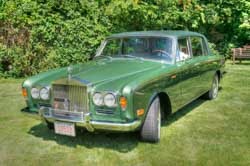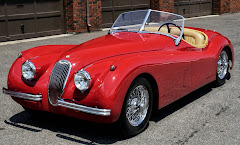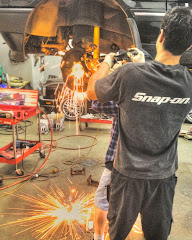What should you look for, when buying insurance for a
collector car? Insurance is a complex thing; something many enthusiasts don’t
come to understand until it’s too late – when they are unhappy or furious over
their treatment when a claim is filed.
In my work managing insurance claims in a repair shop I see
a few common problem areas. Figure these things out with your agent BEFORE buying a policy, and you will head off 99% of the worst potential problems. The first
is total loss value. That’s what an
insurance company will pay you if your car is wrecked beyond repair, burnt to a
crisp, stolen or lost in the ocean. It’s
determined three ways, and it’s VITAL you understand which you have.
AGREED VALUE – this kind of coverage pays the value you
agree upon. Your premiums are typically
xx dollars per thousand, so a $100,000 policy will cost twice what a $50,000
policy costs. If you buy $50,000 of
coverage, and your car becomes a total loss, that is what you will get. If your car is damaged but not a total loss, they will repair it up to this limit. Once repaired, your car will be covered by the agreed value limit once again. This is the only kind of coverage you want
for most collector cars.
STATED VALUE – this sounds like agreed value, but it’s
not. Stated value will pay you the
stated value, or the actual cash value, whichever is less. Let’s say you buy $50,000 of stated value
coverage, and you total the car. The
insurance company finds six similar cars offered for sale at prices ranging
from $28-32,000. Stated value coverage
allows them to offer you $30,000 because that’s the average actual value as
shown in the market. The $50,000 you
thought you had, isn’t.
Stated value is for all practical purposes the same as
actual cash value, but they charge more for it. Stated value coverage benefits the insurance company, but it does not benefit the car collector. I suggest you avoid this coverage.
ACTUAL CASH VALUE – this is the coverage most ordinary cars
carry. The insurance company sets the
rate based on the average value of your car, and if the car becomes a total
loss they pay the actual cash value at that time. On a new Mercedes they might pay $80,000 (almost
what it cost new) where the same car might fetch a $40,000 settlement a few
years later as it had depreciated. This
coverage is usually fair and reasonable for modern cars, where replacements are
easy to get and values are consistent.
It’s not very good for collector cars where value is often in the eye of
the beholder. Expect this coverage on your daily driver, but avoid it for your collector cars.
The next problem area is claims handling. All policies spell these terms out, but few
enthusiasts read the fine print. Here
are a few questions to ask:
What constitutes a total loss, and what about “loss of
collector value?” In many states the
legislature of insurance commissioner has defined what constitutes a total
loss. In many states a total loss is a
loss where the initial damage appraisal equals roughly 70% of the vehicle’s
total loss value. Depending on where you
live, your insurer may or may not have control over this figure. It’s good to know.
In my state, as an example, a $100,000 car that suffers
$60,000 damage will be fixed (not totaled), because that’s the law. You may think it’s terrible and you may think
your car’s collector value has been compromised, but in most cases there is
nothing you can do. So be aware.
Does your policy allow repair with new, original equipment
parts? Or does the policy say the first
choice is used or aftermarket pieces?
Most people prefer the former; most policies provide the latter as the
default. Coverage may differ for glass
and other parts in some states.
Deductibles can vary too.
Does your policy allow you to have anyone fix your car? In some states your freedom of choice among
licensed repair shops is a matter of law.
In other states shops are on some insurer’s approved lists but not
others. If you want the best shop in
town fixing your baby, make sure the policy allows you to make that choice.
Does your policy pay prevailing rates for repair, or do they
set an arbitrary limit? Some places have
a state-approved “standard rate” for auto body labor, which may work fine for
repair of ordinary cars but prove unworkable for collector vehicles that
require special skills. If your car ends
up at a shop that charges $69 per hour, and your insurer pays $38 an hour, you
will probably have a problem.
When dealing with collector cars you should ask if the comprehensive coverage includes rodent damage. If mice eat your wiring or your upholstery will your policy cover that? Rodent damage to upholstery can be extensive, especially on a collector car where new materials might have to be made to order at considerable cost.
Does your policy allow betterment, and if so, when and how
much? Betterment is the term for the
part of a loss you (the insured) are responsible for because the repaired car
ends up “better than before the loss.”
Here’s an example: Let’s say you
have an all wheel drive car that gets into a crash and the two tires on the
right are damaged. The tires are half worn. Your insurance company say they are
charging you 50% betterment because the tires were worn, and they have to fit
new tires to fix the car. Your tire
dealer says you need to replace all four tires because you have an all wheel
drive car, but the insurance company says they are only responsible for what’s
damaged.
That is a normal thing in most places and with most
policies. Betterment may be set by the
insurance commissioner in your state or it may be something you can choose in a
policy. Know what it may be, before you
have to pay it.
If you understand the
points above, and make good choices, you should end up with good coverage that
you understand. What about problems
during the claims process? Sadly, claims
troubles are all too common, but they do not have to be. At my company we’ve handled millions of
dollars in claims and major problems are really rare. But there are shops where every claim ends up
as a fight. What makes the difference?
That will be the subject of my next installment, so stay
tuned




























No comments:
Post a Comment